After a long drought, a bright planet emerges in the western sky. Welcome back, Venus!
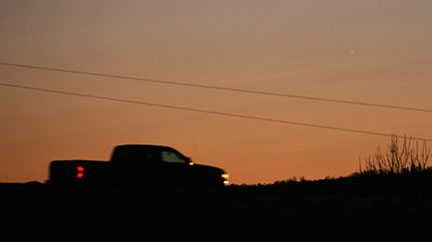
Bob King
Love, beauty, desire, fertility and, prosperity. These are all attributes of Venus. I would like to add another: visibility. Venus has finally returned to the evening sky after hiding in the glare of the Sun for months. It's the first bright planet to hit the evening scene since we got our last glimpse of Saturn at dusk in late November.
Not that finding Venus will be easy. At least for the next couple weeks it lurks near the western horizon at dusk. To see it you'll need to look up your local sunset time so you can begin watching for the planet 20–25 minutes later. Look for a tiny point of light punctuating the yellow-orange twilight glow. Binoculars can be a big help in tracking it down, especially if the sky's hazy.
The sooner you familiarize yourself with the planet, the better prepared you'll be when it comes to viewing the week-long tango between Venus and returning Mercury at the start of March. They'll be closest (1° apart) for the Americas on the 3rd.
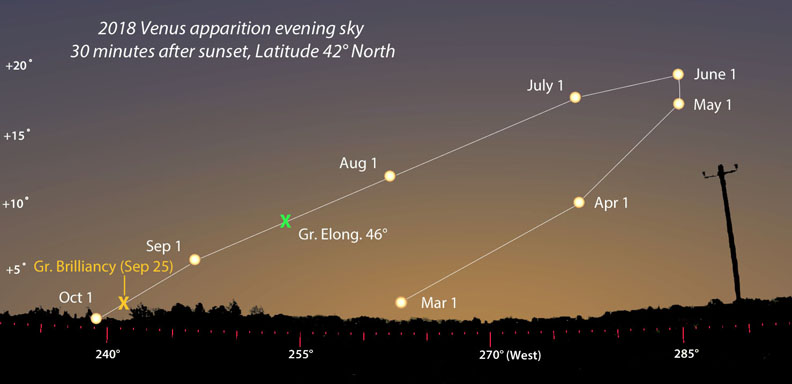
Stellarium, with additions by the author
Venus's journey to this evening apparition began on January 9th, when it was in superior conjunction on the opposite side of the Sun. Six weeks have passed since then and the planet is still 98 percent illuminated and a shimmering, white "full Moon" in a telescope. As an inner planet, it moves more rapidly than Earth (35 km/sec vs. 30 km/ sec) and slowly gains on our planet this winter and spring.
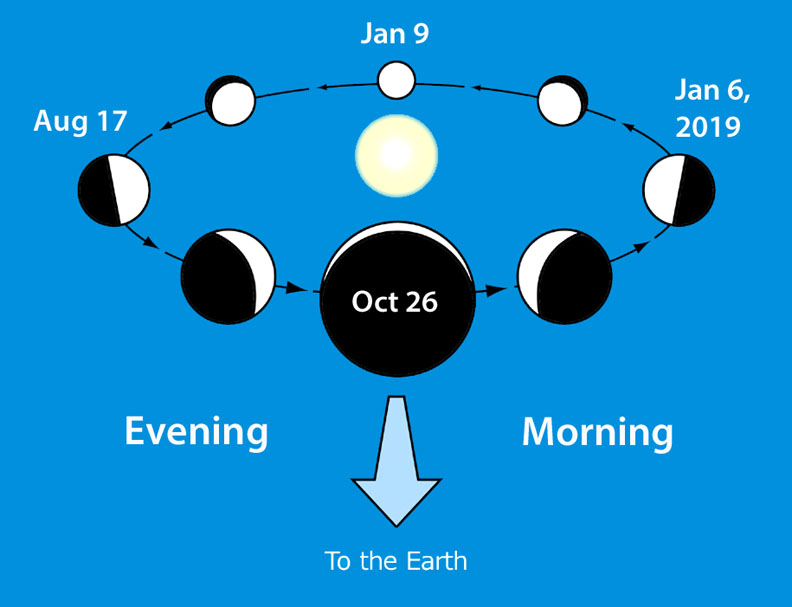
ESO, with additions by the author
The changing geometry between Venus, Earth, and the Sun, combined with Venus's gradual approach, cause the planet's phase to diminish but its size to grow. During the 2018 apparition, Venus will be with us through the beginning of autumn before falling back to the western horizon in early October and transitioning into the morning sky. It never gets particularly high, at least for northern hemisphere skywatchers, with a peak altitude around 20° a half hour after sunset in late spring and early summer. Closer to the equator, the planets manages nearly 35° at dusk.
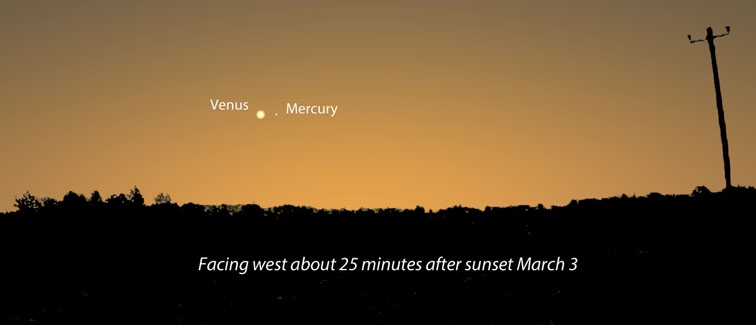
Stellarium
While it's always fun to watch Venus's changing phase and size through a small telescope, seeing markings or textures in its perpetual cloud cover has always been an elusive enterprise. I've never seen anything convincing but have noted that the planet's curved edge appears brighter than the terminator region during most of its phases. I've always attributed this to the angle of the light: At the terminator, the Sun is still very low and its light grazes the clouds versus the edge, where the Sun is higher up and its light more intense.
Some observers recommend a deep blue (#38A) or violet (#47) filter to increase contrast of the clouds or reduce glare. Glare reduction is important when viewing Venus in a telescope. You can either choose a filter (I like red) or plan your observations in early twilight minutes after sundown when Venus is both highest in the sky and tamed by the solar glow.
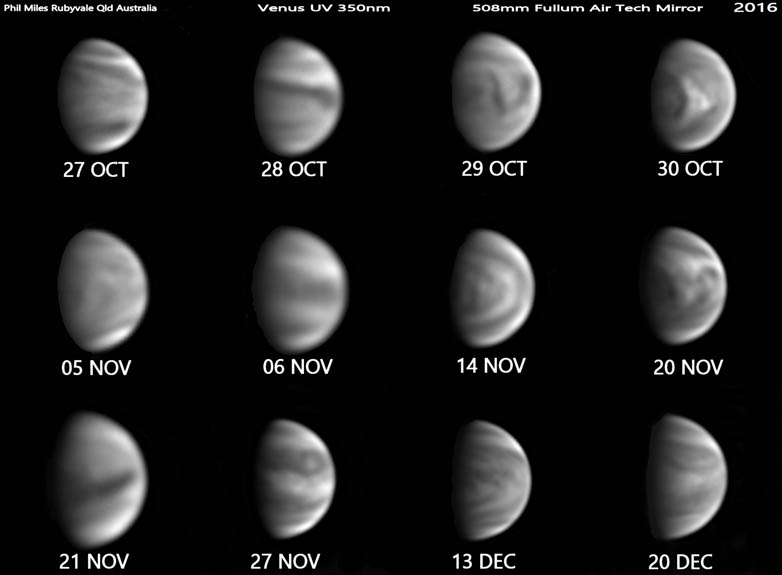
Phil Miles
Clever amateur astronomers have circumvented these limitations by photographing the planet through special ultraviolet (UV) and infrared (IR) filters that transmit only a narrow slice of light. They clearly reveal the characteristic Y-shape of the planet's clouds, which are composed of droplets of sulfuric acid and cycle around the planet in four Earth days, far outpacing the planet's sluggish 243-day rotation.
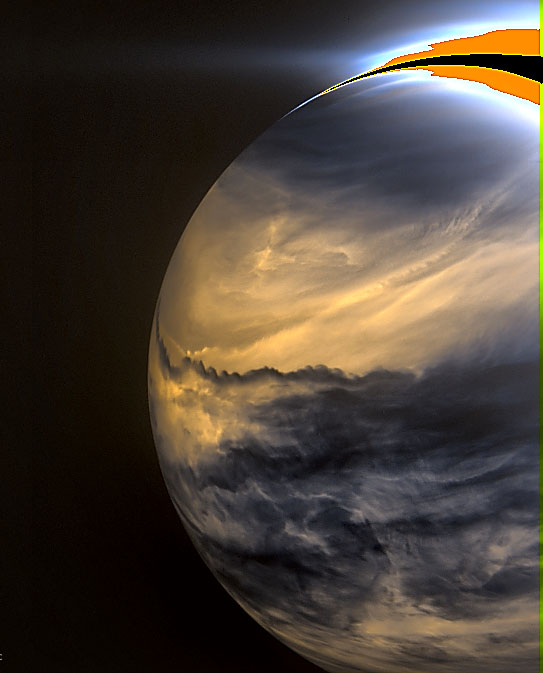
JAXA / ISAS / DARTS / Damia Bouic JAXA / ISIS / DARTS / Damia Bouic
Cloaked in cloud, Venus hides searing surface temperatures of 875°F (468°C), sulfuric acid rain, and an atmosphere so dense, it would crush our lungs — the result of a runaway greenhouse effect spurred by the increased heat the planet receives on account of it being so close to the Sun. In about 1.1 billion years, internal changes in our star will cause it to brighten by about 10%, enough to trigger a similar runaway on our own planet. Peering at Venus in the salmon-colored dusk, it isn't hard to transport ourselves to the distant future, when no matter what we might do today to stave off climate change, it will all be undone by the swelling Sun.
For now, put that thought out of your mind and take in the cosmetic beauty that is Venus.
 20
20









Comments
Joe Stieber
February 22, 2018 at 4:31 pm
I had my first post-superior-conjunction sighting of Venus on January 18, 2018, at 1:20 pm EST with 15x56 binoculars when it was about 2.5° east of the sun, which I blocked with a transformer atop a telephone pole. A week later, on January 25, I saw it in the afternoon again, 4.1° east of the sun, with the 15x56s by blocking the sun behind my neighbor's roof. Later on Jan 25, I picked up Venus just above distant tree tops with the 15x56s at 5:14 pm EST, 3 minutes after sunset. We had clear, deep blue skies here in southern New Jersey on January 18 & 25. Regrettably, personal circumstances and unfavorable weather have conspired against me since then, so I have yet to see Venus with unaided eyes this elongation. I've already tabulated the close approach of Venus and Mercury during the first week of March, but I certainly hope to spot Venus, if not both of them, before then!
You must be logged in to post a comment.
Bob KingPost Author
February 23, 2018 at 12:08 am
Joe,
Once circumstances improve, you'll find it an easy naked eye object now. Good luck, clear skies!
You must be logged in to post a comment.
Jakob
February 22, 2018 at 7:12 pm
Bob,
The brightness of Mercury is a magnitude brighter than yours in the evening of march 3, when using heavens.com information. Could you please explain why? J
You must be logged in to post a comment.
Bob KingPost Author
February 23, 2018 at 12:07 am
Hi Jakob,
My magnitude for Mercury comes from Stellarium, which gives -0.38 on March 3, but I just did a comparison with SkyMap and indeed it gives -1.2 for the same date. This is surprising, since Stellarium has been quite good at magnitudes. I'm going to do another check against a different program, and if it gives -1.2 (along with the US Naval Observatory -- thanks Joe!) I'll change the number. Thanks for drawing my attention to the discrepancy, Jakob.
You must be logged in to post a comment.
Jakob
February 23, 2018 at 3:30 am
Thanks Bob. A "brighter" Mercury Will make the pairing even more beautiful. J
You must be logged in to post a comment.
Bob KingPost Author
February 23, 2018 at 9:21 am
Jakob,
And there's certainly nothing wrong with that 🙂
You must be logged in to post a comment.
Jakob
February 22, 2018 at 8:13 pm
The webbsite should be heavens-above.com!!!
You must be logged in to post a comment.
Joe Stieber
February 22, 2018 at 9:12 pm
Jakob,
Good catch. Bob is showing Mercury at magnitude -0.4 on March 3. The US Naval Observatory's MICA, SkyTools, SkySafari and Heavens-Above all show magnitude -1.2 on March 3 at 18:00 EST (23:00 UT). I know it's hard to imagine, but I guess Bob made a mistake .
You must be logged in to post a comment.
Bob KingPost Author
February 23, 2018 at 12:08 am
Hi Joe,
Check my reply to Jakob. My figure for Mercury's magnitude comes from Stellarium, but the program may be in error.
You must be logged in to post a comment.
Frank-ReedNavigation.com
February 23, 2018 at 2:15 am
OK, but when I check in my copy of Stellarium (ver. 0.16.1), it shows -1.2 just like all those other software tools.
As a relatively casual open-source "team" project, Stellarium is a bit prone to errors in observer-dependent data (things like magnitudes and atmospheric refraction), but most get fixed soon enough when the errors are posted to the community. Is it possible you have a considerably older version of Stellarium installed?
You must be logged in to post a comment.
Bob KingPost Author
February 23, 2018 at 9:20 am
Hi Frank,
Aha! I was using v0.15.0 and just updated to 0.17.0.1. Now, not only is Mercury brighter (-1.21) but life feels a little cheerier, too. Thanks for the suggestion, Frank!
You must be logged in to post a comment.
Joe Stieber
February 23, 2018 at 6:16 pm
Bob,
I put a smiley thing after the word "mistake," but it didn't come through. Sorry about that!
You must be logged in to post a comment.
Fabrice Morat
February 24, 2018 at 4:21 pm
Hello Bob,
A week ago (February 16th), by sheer chance, i've mixed your december post (What’s the Thinnest Crescent Moon You Can See?) with your current article. So that evening, i've seen easily Venus before the sunset first in the big bino 25x141mm then at the naked eye. But the younger moon was more difficult, i had to wait many minutes before seeing it. (not a record, 22h24 old !). Howether, it was a nice conjonction because the two objects were in the same field... Thank you for your illustrated article, i will try to look on the sea Mercure and Venus on march 3.
Fabrice.
You must be logged in to post a comment.
Bob KingPost Author
February 25, 2018 at 11:17 am
Hello Fabrice,
You're welcome! I'm a little jealous about not seeing that young moon. I drove to high point, but it took longer than I expected to arrive, so I missed the moon. But of course there will be another. That's what I like about astronomy.
You must be logged in to post a comment.
Joe Stieber
February 26, 2018 at 8:47 pm
I too had been looking forward to the crescent moon near Venus on February 16, but my hopes were dashed by a heavily overcast sky. However, today (February 26), clouds cleared out late in the afternoon and I was finally able to see Venus with unaided eyes, picking it up 3 minutes after sunset (shortly after arrival at the local baseball field complex). While there, I also spotted Mercury, 4 minutes later with 15x56 binoculars, 3.6 deg below Venus. I was not able to see Mercury with unaided eyes.
You must be logged in to post a comment.
Bob KingPost Author
February 27, 2018 at 8:01 pm
Great to hear about spotting Mercury already, Joe. Hoping to catch it this weekend in conjunction.
You must be logged in to post a comment.
Tom-Reiland
February 27, 2018 at 1:19 am
Bob, I finally got a chance to observe Venus Monday night at 15 minutes after sunset. It was easy to spot through my 10 X 50 binoculars and, later, with my nude-eyes. I didn't have any luck with Mercury, but I didn't do any preparation to locate it. Tonight was one of the clearest nights of the year, but the Moon hindered most Deep sky observing. I was able to find NGC 3941 and got another look at the Supernova, SN2018pv. It's still between 12.5 and 13 magnitude. Here's hoping we all have a clear Saturday evening to observe Venus and Mercury. The Moon will rise about 8:15 in Western Pa that night giving us less than an hour of dark skies for observing.
You must be logged in to post a comment.
Bob KingPost Author
February 27, 2018 at 8:04 pm
Hi Tom,
Good to know you got a look at the radiant planet and that 2018pv is still bright. I may add to tomorrow's blog if I have time.
You must be logged in to post a comment.
Tom-Reiland
March 2, 2018 at 11:02 pm
Except for the wind, with some strong gusts to 40 mph, it was a very good night at Wagman Observatory. I was able to see Venus and Mercury through the 21" separately, but I could see both of them in the 5" at 25X and in my 10 X 50 binoculars. Eventually I saw both of them with my nude eyes. I brought the H-Beta Filter that I recently received to test it on the 21" Manka Scope and it passed with flying colors. Even though twilight had not ended and the Moon was hidden behind the clouds in the East, I was able to see the Horsehead Nebula with the aid of the H-Beta Filter. I was pleasantly surprised that it was visible under these conditions. Transparency was excellent, though the sky was not totally dark. It also greatly enhanced the view of the Orion Nebula and the reflection Nebula in front of the Pleiades. I finished with the Andromeda Galaxy and the beautiful double star, Eta Cassiopeiae.
You must be logged in to post a comment.
Venus
February 27, 2018 at 4:18 pm
Loved this thanks Bob!
You must be logged in to post a comment.
You must be logged in to post a comment.